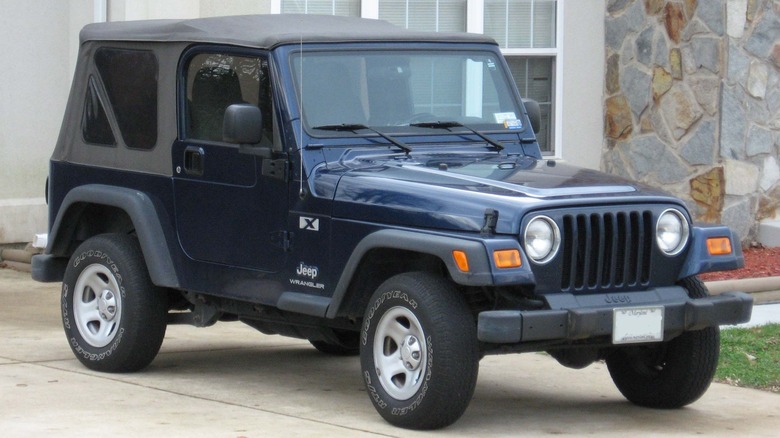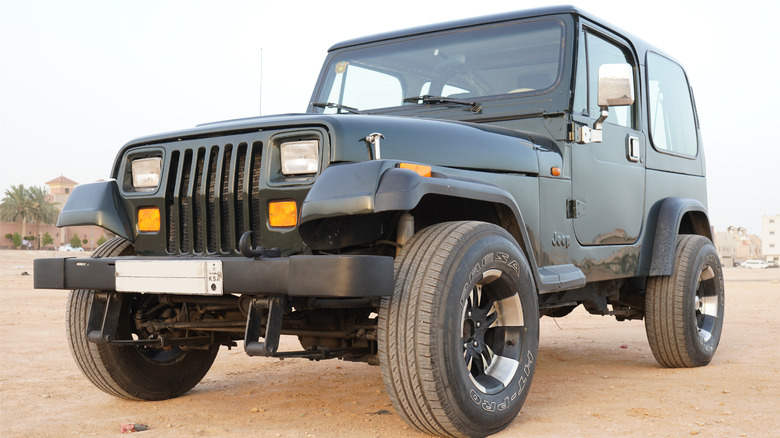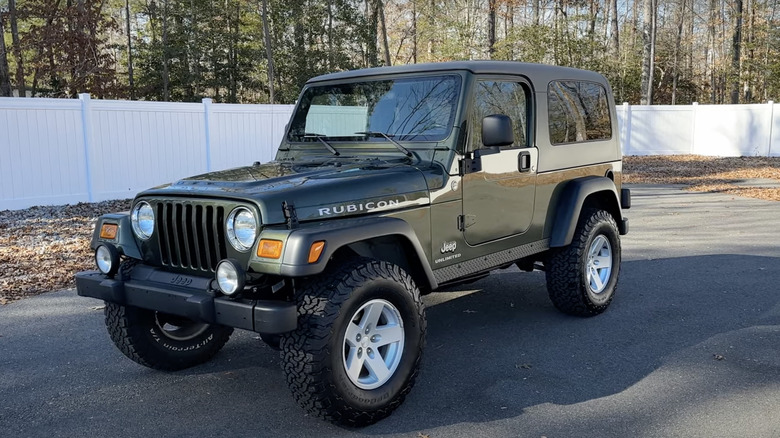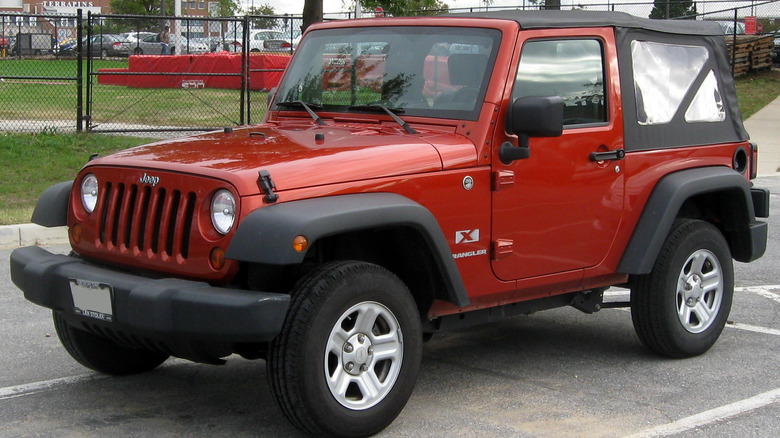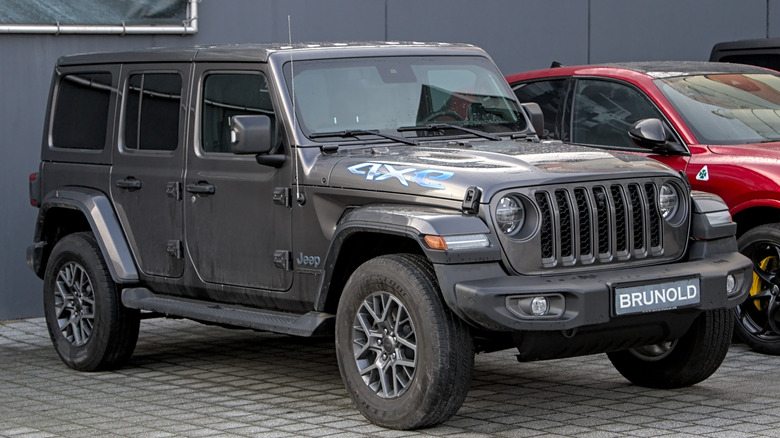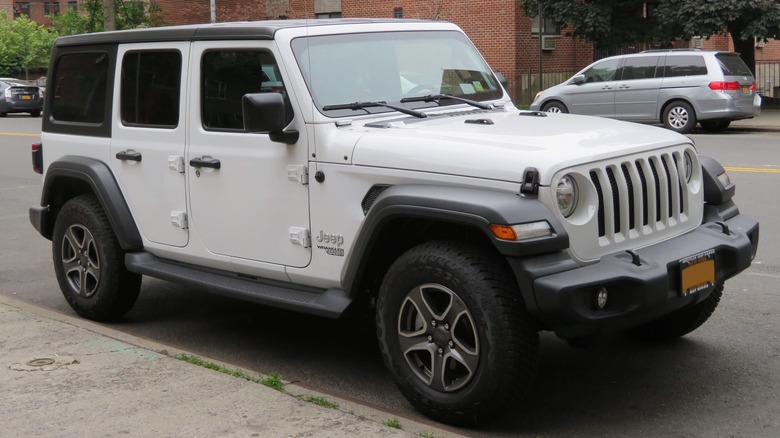The Best Years For Jeep Wrangler (And Some To Steer Clear Of)
Early Jeep CJ models that evolved from the Quad that Willys Overland built for the Army in the 1940s were gradually made more civilian-friendly over the next few decades, with the very similar CJ-5 and CJ-7 representing the last of that line. When Chrysler purchased the Jeep brand along with AMC in 1987, it replaced the CJ-7 with the Wrangler, which was more highway-ready than the CJ, yet still a capable off-roader. Jeep has sold more than five million of the stubby SUVs since then, adding modern features like airbags, GPS navigation, and anti-lock brakes along the way.
We ranked the various Wrangler models by generation recently, but there have been small changes from year to year that make some vintages highly desirable and others problematic. Here is a deeper dive into which are the best model years for the Jeep Wrangler, and which ones you might want to steer clear of if you're shopping for a dependable, low-maintenance ride.
1994 and 1995 are the best years for the YJ Wrangler
The first-generation YJ Wrangler ranked second on our list above, due in large part to the durability of its 2.5-liter four-cylinder engine and more robust inline sixes. For the Wrangler's first few years, both the 2.5 liter I4 and the 4.2-liter straight six were fed fuel through a carburetor, which made them finicky when changing altitude or going up a steep grade. In 1991, Jeep began topping both engines with a fuel injection system made by Renix, a joint effort between Renault and Bendix. Although it had been previously used on the XJ Cherokee, the Renix system had a wonky knock sensor and was unable to store problem codes. Chrysler replaced it with a more advanced multi-port fuel injection system, but the quality of those early injectors was below par. Better injectors came in 1993, but standard transmission Wranglers made up to that point had a design quirk that made one particular repair task much more difficult than it needed to be.
Until 1994, stick-shift YJs had the clutch secondary cylinder mounted inside the bellhousing of the transmission, and replacing it required separating the transmission from the engine and replacing the bellhousing along with the throwout bearing and clutch fork. You can buy an upgrade kit or swap salvage yard parts from a '94 or '95 YJ into an earlier model, but that, too, requires pulling the transmission. It's best to seek out a YJ from those last two years with the external hydraulics.
Early TJs had bugs, but 2005-2006 models are among the best Wranglers
Jeep gave the Wrangler a major refresh for the 1997 model year after a one-year hiatus. Big changes included the return to round headlights, which pleased Jeep purists. Along with the big changes came some issues, though. Those earliest TJs had engine computer gremlins and issues with the fuel system and brake hydraulics. Seven recalls were issued for the 1997 model, including one for airbags that might not offer the necessary protection in a crash. Jeep worked out most of those problems over the next few years, and mid-to late-generation TJs are among the most desirable Wranglers. Beginning in 2001, Wranglers got a better ABS system and updated center consoles and soft tops.
In 2003, the Wrangler got two new transmission options to go along with the introduction of the trail-oriented Rubicon trim. The four-speed automatic 42RLE was the first Wrangler auto to have four gears, and the New Venture 1550 five-speed replaced the older Aisin-Warner manuals. Stick shift aficionados will want to hunt down a 2005 or 2006 Wrangler, though. For those two final years of the TJ, manual Wranglers got the NSG370, Jeep's first-ever six speed. Those were also the last years for the 4.0-liter I6 in the Wrangler, as that engine gave way to a new 3.8-liter V6. A special case can be made for the 2004-2006 Unlimited, which is known as the "LJ" for its extended wheelbase that added some valuable space in back for passengers or gear.
2007-2018 Wranglers have added features but significant issues
When the third-generation JK Wrangler debuted in 2007, it was the first to be offered with a four-door option. Just as the earliest TJ Wranglers had some design issues, so too did the first few years of the JK. The 2007 model was the subject of several recalls regarding potentially dangerous conditions. Automatic transmission-equipped Wranglers had no fluid temperature gauge or warning light, and a boil over could cause a fire in the engine compartment. Two separate recalls were issued for early JK airbags, including one similar to a recent recall of Takata airbags, where fragments from the inflator could injure the driver and/or passengers. A lack of proper weather sealing around the front doors led to water leaks from the newly implemented "Freedom Panels," and the new V8's peak power output came too high in the rev range to make it good for off-road use.
This engine was also prone to burning excessive amounts of oil, and often did not last as long as the 4.0-liter I6 it supplanted. These issues and five recalls of the 2017 model landed the JK last in our ranking of the four Wrangler editions, but the JK era wasn't a total loss. Stability and traction control first appeared on the JK, along with hill-start assist and trailer sway control. 2012 and 2013 are the standout years for this Wrangler, largely because the 3.8-liter V6 was dumped for a 3.6-liter version that most Jeepers favor for its better performance across a wider rev range.
[Featured image by IFCAR via Wikimedia Commons|Cropped and scaled|Public Domain]
New powertrains and interior upgrades make some recent Wranglers attractive
The newest era for the Wrangler began in 2018 and brought some welcome upgrades. That year, the new JL was sold along with the outgoing JK, with only a few subtle cosmetic changes to distinguish the two. Lighter metals were used for some body parts, and a new 2.0-liter turbocharged I4 also helped boost fuel mileage. The 2018 Wrangler stands out as one that was particularly problematic. The National Highway Transportation Safety Administration issued 11 recalls for this model year, and owners logged more than 1,000 complaints about this vintage Wrangler. Most were for its tendency to wander at highway speeds. Those steering-related complaints lingered through the next two years, but were much less frequent.
Fresh engine choices make the 2020 and newer Wranglers a more enticing buy. A 3.0-liter Ecodiesel V6 came that year, providing 260 horsepower, 442 lb-ft of torque, and an impressive 0-60 time of 7.5 seconds. An eight-speed automatic was also available, which could be paired with one of five engines. Three were familiar: the 3.8-liter V6, the 3.0-liter Ecodiesel, and the 2.0-liter turbo four. In 2021 a 470-horsepower, 392 cubic inch HEMI was made available in the Rubicon 392, and the hybrid Wrangler 4xe was also there for more eco-conscious buyers. Both of those models stayed in the lineup through 2024, but that will be the swan song for the 392.
[Featured image by Alexander Migl via Wikimedia Commons|Cropped and scaled|CC-By 4.0]
Methodology
To compile these recommendations, we considered three main factors: the drivetrains and features available for a specific model year Wrangler, the quantity, and severity of National Highway Transportation Safety Administration recalls, and previous reporting here at SlashGear and from other well-known, reputable outlets. Owner experience from reputable Jeep forums was sought to confirm our conclusions, but was never used as a basis for any suggestion, pro or con. In addition, some of the suggestions here were based on my personal experience owning, restoring, and driving more than a half-dozen Jeeps, including three YJ Wranglers and one TJ.
[Featured image by Kevauto via Wikimedia Commons|Cropped and scaled|CC-By 4.0]
